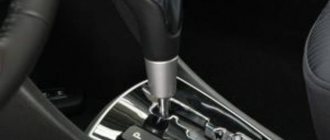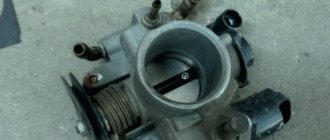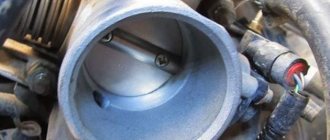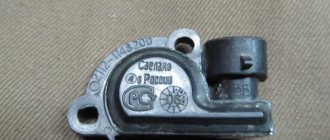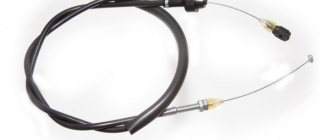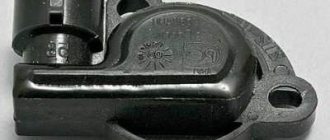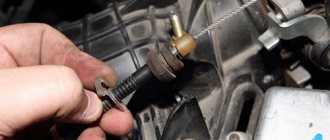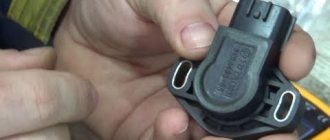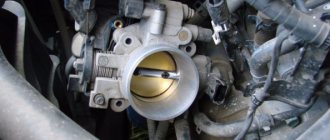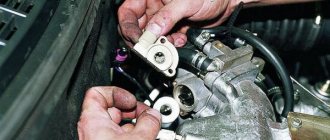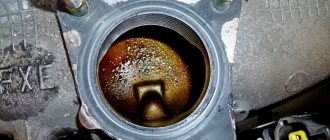Signs of trouble
The problem with many VAZ 2110s is that until a serious increase in speed, the car remains, as motorists say, in a “sluggish” state, it does not pull, and becomes more or less playful only when the revolutions reach approximately the 3000 mark.
This is very often associated with improper throttle operation. Moreover, the main culprit may be the manufacturer, but more on that later. And now - about some more signs of malfunction:
- engine speed fluctuates;
- there is no clear response from the car when you press the gas pedal;
- when changing gears, jerking can be observed;
- vibration is observed when the car is idling;
- stalls when changing speed;
- The engine does not start well if the car is already warmed up and then turned off.
Evidence of pollution
Don't forget that the throttle valve can become dirty. Signs of this are the following criteria: the engine begins to stall, lose speed, the engine starts with difficulty, at the minimum speed of the car, jerking begins. Always check the throttle assembly for causes of problems. Damper contamination occurs in many cases. Settlement occurs on the walls of the mechanism, entering the assembly due to ventilation of gases. Another reason is poor filter performance.
Correction of a factory miscalculation
It is quite common for a throttle assembly to come out of the factory with something that cannot even be called a defect, but can still be attributed to design errors. In theory, air should flow into the space behind the throttle, for which a channel of approximately 2.5 mm is specially made.
But the whole problem is that this channel was pressed against the wall of the receiver, thus blocking the possibility of air flow. A slight modification of the throttle assembly can help in this case.
Bored channel for air flow in the throttle
To do this, just take a file and use it to make a small groove in the indicated place. 2 - 3 mm will be enough. But before doing this, it is necessary to remove the throttle.
Dismantling
On a VAZ 2110, the throttle assembly is removed in the following sequence:
- Disconnect the connectors of the sensor that regulates the position of the throttle valve, its drive cable and the XX regulator;
- We partially drain the coolant;
- Next is the removal of the air hose located on the body of the mass air flow sensor. Why do you just need to loosen the clamp;
- We also loosen the clamps: where the throttle pipe is attached to the air hose; where the hose of the 2nd crankcase exhaust circuit is attached to the cylinder head cover pipe. We remove the connected hoses - the air and 2nd crankcase ventilation circuits;
- Having loosened the clamp, remove the hose of the 1st crankcase gas exhaust circuit from the throttle assembly fitting;
- Having loosened the clamps, we remove the hoses supplying and discharging coolant;
- You will need a wrench with a 13mm head, with which you need to unscrew the nuts securing the throttle assembly to the receiver on a VAZ 2110;
- It is now possible to remove the throttle assembly from the studs;
- It remains to remove the sealing gasket and, if your VAZ 2110 has a system that traps gasoline vapors, disconnect the hose for purging the adsorber.
Throttle assembly VAZ 2110 | VAZ 2111 | VAZ 2112 - removal and installation
RECOMMENDATION The throttle assembly on VAZ 2110, VAZ 2111, VAZ 2112 vehicles can be removed without draining the coolant. This will require two M10 bolts as plugs.
WARNING Start work only after the engine has cooled down to a safe temperature (not higher than 45°C).
Removing the throttle assembly
1. We prepare the car for repairs (see paragraph 2a Preparing the car for maintenance and repair). 2. Remove the wire terminal from the negative terminal of the battery (see paragraph 2 Battery - removal and installation). 3. Remove the decorative trim of the engine (see Decorative trim of the engine - removal and installation). 4. By unscrewing the expansion tank cap, we relieve excess pressure from the engine cooling system. 5. Remove the air supply hose to the throttle valve. 6. Disconnect the throttle valve drive cable from the sector (see paragraphs 3 and 4 Throttle valve - replacing the drive cable) 7. Disconnect the wire connector from the TPS (throttle position sensor). 8. Disconnect the wire connector from the idle air control (see paragraphs 2 and 3 Idle air control (IAC) - check and replacement). 9. Use a Phillips screwdriver to loosen the clamps securing the crankcase ventilation system hose and two coolant supply hoses. . and adsorber hose.
14. While holding the throttle assembly in a raised position, remove the coolant supply hoses from the throttle body fittings. 15. Insert M10 bolts into the hoses. To prevent them from falling out, tighten the hose clamps.
Throttle assembly installation
We install the throttle assembly and all the removed parts on the car in reverse order.
useful tips for motorists
Cleaning
Even if the purpose of removing the throttle was to modify it, still do not forget that for stable operation it also needs periodic cleaning. To be honest, there is nothing complicated in this procedure, but it will help the engine run better, which is quite important.
For cleaning you will need:
- short and long screwdrivers;
- toothbrush (soft, or just old);
- cotton buds;
- cleaning agent;
- rubber or cotton gloves.
For cleaning to give the desired result, it must be carried out very carefully. First, you can go through all the cavities with a toothbrush, at the same time cleaning the idle speed control (it must also be removed). Further, more delicate, cleaning is done with cotton swabs. Pay special attention to the area where the throttle valve is located and the place where the XX regulator fits.
Please note that cleaning the crankcase ventilation duct with conventional means is not possible, but it can be easily done using the foot pump available in each trunk. The diameter of the fitting is similar to the wheel one, you just need to add cleaning agent and pump your foot several times.
If you have problems mentioned at the beginning that started recently, cleaning should fix them. If there were problems from the beginning, do not forget about improvements. Sometimes only replacing the throttle assembly helps.
Step-by-step cleaning instructions
If the damper does get dirty, it doesn’t matter; with the help of several cleaning steps, the car’s operation will be restored. Before cleaning, you must remove the throttle assembly according to the following instructions:
- remove the corrugation;
- turn off the power supply to the sensors;
- push out the “weight” that secures the pedal cable;
- disconnect the coolant pipe;
- remove the ventilation hose; unscrew the assembly fastening;
- Unscrew the idle speed control.
To clean mechanisms, special products are required, in most cases aerosol cans. The best solution for this task is a carburetor or brake cleaner.
Purpose and design of the throttle valve
The throttle valve in a VAZ 2110 car is a whole unit that is installed in the air duct system. At the inlet there is a pipe from the air filter, the outlet is connected to the intake manifold. The throttle must regulate the flow of air that enters the engine. Due to this, the motor power is regulated.
The design of the throttle valve (VV) uses an actuator. It can be mechanical or electronic. The throttle position directly depends on the position of the gas pedal.
An important element in the DS is the throttle sensor. On the VAZ 2110 it is made in the form of a potentiometer that produces a signal. It changes depending on the throttle angle. This signal is sent to the engine electronic system. The electronic control unit doses the incoming fuel.
During operation, the throttle valve assembly becomes dirty. Fuel combustion products can settle on the side of the collector, and dust on the other side. The presence of contamination in the throttle valve of the VAZ 2110 affects the stable operation of the engine.
The main signs of contamination in the throttle valve block:
- poor vehicle acceleration dynamics;
- Unstable engine operation at idle;
- The car moves jerkily, there is no smooth ride.
If these signs appear, it is recommended to clean the throttle valve on the VAZ 2110. To carry out this operation, special auto chemicals are used. The most commonly used product is to clean carburetors.
Cleaning the throttle body will cost much less than buying a new throttle body for a VAZ 2110. The price of a new unit is several times higher.
To clean the throttle unit with your own hands, you must use the following materials and tools:
- screwdriver;
- set of tools with keys and heads;
- new throttle body gasket;
- protective gloves;
- carburetor cleaner;
- ear sticks for hard-to-reach places;
- old toothbrush.
The procedure for cleaning the throttle valve on a VAZ 2110:
1. Raise the hood of the car. Remove the terminals from the battery. It is enough to throw off the negative terminal. To do this, we use a key set to 10. 2. Dismantle the receiver. Loosen the clamps on the 5 pipes. We remove the pipes. Four pipes are visible from above, the fifth is located under the throttle valve assembly. 3. Disconnect the connectors from the sensor on the throttle valve and the idle air control (IAC). 4. Disconnect the throttle control cable. 5. Unscrew the throttle block from the receiver with a key. 6. Using a screwdriver, unscrew the idle speed control crosswise. We remove the IAC from the throttle block. 7. Using a cleaning product, an old toothbrush and ear sticks, we clean the throttle unit. We pay special attention to the channels and landing sites of the IAC. Remove carbon deposits and dig. Before using a special carburetor cleaner, you can wash the unit with plain gasoline. 8. It is recommended to apply lubricant to the idle speed control rod. To do this, we use silicone grease, which will help extend the service life of the IAC and the throttle unit as a whole. 9. Assemble the throttle assembly. We screw it to the receiver, not forgetting to install a new gasket. We connect all pipes and connectors.
An important part of the throttle valve is the “nickle”. Some car enthusiasts bore out the assembly chamber and install a “penny” of increased diameter. This can achieve a more enriched combustible mixture. Motor power increases. It is better to entrust the engine tuning operation to a motor specialist. You should not carry out such an operation on your own, without good preparation.
Another reason for unstable behavior of an internal combustion engine may be a faulty throttle sensor. On a VAZ 2110, you can replace the sensor yourself. Its price is low. It is recommended to use a non-contact sensor. Its cost is slightly higher, but the sensor will last significantly longer.
You can diagnose the sensor yourself. For this you need a tester. Let's look at it step by step:
- The ignition must be turned on. We measure the voltage between the potentiometer contact and the “minus”. The correct value on the voltmeter is 0.7 Volts.
- We turn the plastic sector to the limit, thereby opening the damper completely. The voltmeter should show 4 Volts.
- The ignition should be turned off, disconnect the connector from the sensor and measure the resistance of the potentiometer of the remote sensing sensor.
- We smoothly turn the sector and observe the tester readings. If the sensor is working properly, the needle will move without jerking and smoothly. If this is not the case, then the throttle sensor should be replaced.
Description and performance check of the VAZ 2110 throttle valve
Let's look at the example of the throttle on a VAZ 2110 car. The position of the throttle valve on a VAZ 2110 is the engine compartment. The type of drive in this car will be mechanical, we discussed this earlier. The throttle position sensor itself on a VAZ 2110 car is located in the throttle assembly; it is popularly called the “right foot sensor”.
It is used to measure the amount of throttle opening and transmits information to the car's engine block. The sensor operates on the principle of a conventional resistor. A resistor is an element of an electrical circuit that has a certain or variable resistance. Sensors can be contact or non-contact. In the car it is located on the throttle pipe and connected to the damper. The main danger is that if it malfunctions, information regarding the throttle position will be distorted.
The VAZ 2110 throttle valve and injector are important components responsible for supplying air and fuel to the engine cylinders. Many owners of this car model have a desire to check the functionality of the VAZ 2110 throttle sensor. And more than once this situation has baffled drivers. Now we will tell you about this; with the ignition on, you need to use a voltmeter to check the “minus” and the contact of the voltage element.
The reading should not be higher than 0.7 V. Then open the damper, turn the plastic sector and measure the voltage again. Now the sensor should show at least 4 V. With the ignition on, pull out the connector, check the resistance, turn the sector and see how the device readings behave. If they jump, then urgently replace the sensor, preferably with a non-contact one. Motorists say it will last much longer.
Having checked many sites for selling auto parts and comparing the cost of the throttle, we can say that the average price of a VAZ 2110 throttle body is 2 thousand rubles, or even higher. When purchasing this part for your car, do not forget to consult with the seller.
Throttle valve, potentiometer, idle speed controller
Gasoline is used as fuel in the internal combustion engines of VAZ-2109, VAZ-2110 and other models produced or produced by the Volzhsky Automobile Plant. However, in the cylinders it does not burn on its own, but in a mixture with air. The throttle valve is needed to prepare the air-fuel mixture in the required proportions. It is located behind the air filter in front of the intake manifold.
Basically, the throttle valve is an air valve that regulates the amount of air entering the engine. The principle of its operation is to change the cross-section of the air channel. When it is fully open, air flows freely into the intake manifold. To determine the opening angle, a throttle position sensor is used, which is connected to the engine control unit. Based on the signals transmitted by the sensor, the control unit issues a command to increase the amount of fuel injected, the working mixture is enriched, and the engine operates at maximum speed.
The smaller the throttle opening angle, the less air enters the manifold, and the lower the engine speed.
Electronic throttle valve: how does it work and how to repair it?
The trend in automotive engineering in recent years has been the systematic removal of the driver from direct control of the car. So far, thank God, we have not reached the point of losing the rigid connection of our arms and legs with the turning wheels and brakes, but everything is clearly heading that way... At least, not a single car these days is produced without an electronic throttle, with which we We do not give a direct command to the throttle “more air!” with the right foot through the cable, and express a wish to the engine control unit, which itself sends a command to the damper. Is this good or bad, and how to live with it?
Background
It is generally accepted that the so-called E-gas is a technology of the last decade or so. In its pure form - yes, but the integrated electric drive in throttle valves appeared much earlier - back in the 80s. In those years, on the damper axis, on one side there was a gas sector connected to the accelerator pedal with a classic cable (yes, the “wheel” that is driven by a cable from the pedal is called the “gas sector”!), and on the other side, the damper axis connected through a gear transmission to a small electric motor.
Actually, the motor had no influence on the behavior of the car when moving - the connection with the driver’s foot was old-school, mechanical and clear: as you press, so will you go! And the electric motor started working only in idle mode, adjusting the speed of the damper slightly during warming up and after warming up, and also slightly adding gas when turning on powerful consumers of electricity and torque - air conditioning in the summer, power steering in the cold, various heating systems, etc. A little later, the functions of the motor in the throttle expanded - with an almost unchanged design, electronic commands were added: it began to control not only idle speed, but also speed while driving - when the cruise control is turned on and when the traction control system is activated.
Now everything has reached the “apophygea of technology” - the mechanical connection between the damper and the gas pedal has disappeared in principle, and all commands - both from the driver’s foot and from service systems - are received by the throttle only through the mediation of the engine control unit. There are three reasons for this:
- Environmental requirements;
- Increased fuel economy;
- Convenient implementation of many modern car functions.
Electronic throttle these days
So, the direct connection between the throttle valve and the pedal has been completely and completely abolished. As I already said, by pressing the pedal we send a signal to the control unit, which in turn analyzes the situation and many parameters, and then issues a command to supply air. At the same time, it must be said that over a good ten years of development of the tandem of an electronic gas pedal and an electronic throttle in its modern understanding, the system has successfully outgrown a number of childhood diseases - both purely physical and software.
Wearing sliding contacts of damper position sensors have been replaced by non-contact inductive coupling, and many new functions have appeared - not so obvious as to take a line in the technical description of the car, but quite important in the complex.
For example, the gas pedal travel has become non-linear, which makes it possible to better control the car when starting to move: with a powerful engine (where the damper has a large diameter), the risk of excessively rushing forward when lightly touching the pedal has disappeared - the electronic throttle reacts deliberately sluggishly in the first quarter of the gas pedal travel .
E-gas allows for the most optimal acceleration in a car with a turbocharged engine, significantly combating turbo lag and providing smoother acceleration from the bottom. E-gas will also help in the “pedal to the floor” mode, when in the case of a classic cable damper, the first moments of non-optimal combustion of the mixture occur, and seconds are lost during acceleration. Of course, we cannot fail to mention the effective automatic engine traction control system to combat drift and slippage of the drive wheels.
Throttle valve device
The throttle valve itself is a round plate capable of rotating 90 degrees around its axis (from fully closed to fully open). It is installed inside the housing, where its drive, idle air control (IAC) and throttle position sensor are located. All these elements together form the throttle body or throttle assembly. It should be noted that on the VAZ-2109 with an injection engine, the VAZ-2110 and the VAZ-2115, the same unit is used.
The design of the throttle body is not as simple as it might seem at first glance. Among other things, it is also part of the engine cooling system. It has channels for coolant circulation. It is also equipped with pipes, one of which is connected to the engine crankcase ventilation system, and the second to the gasoline vapor recovery system.
Idle speed control
The idle air control is an electromechanical device whose task is to maintain a certain crankshaft speed when the throttle valve is fully closed. For example, while the engine is warming up or the load changes, when additional equipment is turned on. The design of the idle speed controller is as follows: inside the housing there is a stepper electric motor, to which a spring-loaded conical needle is connected. When the engine is idling, the needle, moving back and forth, adjusts the cross-sectional area of the bypass air channel through which air passes when the damper is fully closed.
The throttle valve can have two types of drive:
- mechanical, like VAZ-2109, VAZ-2110, VAZ-2114;
- electric, which is used on most modern cars.
Mechanical drive
For the VAZ-2109, VAZ-2110 and other outdated models of the Volzhsky Automobile Plant, the throttle valve is connected to the gas pedal via a steel cable. The mechanical drive has a very simple design and low cost, so it is still used on many inexpensive cars.
Electric
If the throttle valve is equipped with an electric drive, then there is no direct connection between it and the gas pedal. The principle of operation of an electric damper does not change, but its design is much more complex. Simplified, such a node works as follows. The force of pressing the gas pedal is recorded by a special sensor, which transmits this information to the engine control unit, the throttle opening angle is determined by the throttle position sensor, and also transmits the corresponding signals to the control unit. The controller constantly compares these values and sends commands to the electric motor to increase or decrease the damper opening angle.
The main distinguishing feature of the electric throttle valve is the absence of an idle speed control. When the engine is idling, the throttle valve does not close completely; its opening angle is set by the control unit in accordance with the operating parameters of the power unit. The electronic throttle, unlike the mechanical one, has not one position sensor, but two. If one sensor, also known as the throttle potentiometer, fails, the throttle assembly will still work.
Repair work
Now to the question of how the cleaning procedure is performed. For everything to go smoothly and without problems, it is enough to prepare all the necessary materials and tools in advance, place everything at hand and get to work.
To clean the throttle you will need:
- Screwdriver Set;
- 13mm wrench;
- Throttle valve cleaner.
Specialized preparations made from appropriate components are sold specifically for these purposes. Do not spare money on their purchase, since the funds will last for a long time. This is more profitable than changing the damper every time.
Cleaning with special means
Preparation
Let's start with the preparatory activities that will ultimately allow you to get to the throttle body and more and clean it properly.
- Remove the casing that is installed on the power unit.
- Unscrew the cap on the expansion tank. This will allow you to relieve excess pressure from the cooling system.
- Slightly loosen the tension on the mounting clamps, then remove the forced ventilation tube.
- Examine the current condition of the air pipe, which should also be removed and, if necessary, replaced.
- If there are significant traces of oil in the pipe, then you can be 100% sure that the throttle is definitely clogged.
- The problem is most likely in the forced ventilation duct. This is explained by the fact that contaminants in the form of gas from the crankcase and oil particles have no other way than through the ventilation branch.
- Next you need to remove the damper heating tubes. To do this, just loosen the clamps with a screwdriver.
- For a while, come up with plugs for them from improvised means - old spark plugs, some kind of non-hollow rubber bands. In short, anything that fits the diameter of the hole.
- Remove the fuel tank ventilation system hose. To do this, you must first unscrew the clamp, remove the cable and unscrew the throttle mounting nuts.
- Be sure to remove the connectors from two sensors - idle speed and throttle position. They are located on the unit being repaired, so there will be no problems with the search.
Throttle position sensor
This sensor is a potentiometer. When you press the gas pedal, the position of the damper and the voltage supplied to the controller changes. When closed, the voltage is 0.7V, when fully open it is 4V. In accordance with these data, the sensor controls the fuel supply.
If a malfunction of the position sensor occurs, the controller will not be able to correctly determine the position of the damper. This results in the following malfunctions:
- in all engine operating modes, the speed begins to fluctuate; at idle, the speed will be increased;
- when you switch off the gear (neutral) while driving, the engine may stall;
- Sometimes the CHECK light may come on.
To check the functionality of the position sensor, you can use a multimeter. With the ignition on, the probes are connected to connectors B and C. Changing the position of the damper should lead to a change in voltage.
What is a throttle valve? And possible problems with it
Essentially, the throttle body is a valve located between the air intake and the intake manifold.
In an electronically controlled fuel-injected vehicle, the throttle position sensor and airflow sensor communicate with the computer, which delivers the appropriate amount of fuel needed to the injectors.
In the closed position, the throttle body cuts off almost all air flow, but when it is wide open, it will make your engine roar.
In older carbureted engines, the choke is built into the carburetor.
While driving, you constantly open and close the throttle (without even noticing) every time you use the gas pedal.
When this happens, the throttle position sensor tells the ECU that you have pressed on the gas.
And the airflow sensor detects more air and sends a message to the car's computer to increase the amount of fuel supplied by the injectors.
Modern engine with throttle body
More modern cars use an electronic sensor to tell the on-board computer how much fuel to deliver based on the incoming air flow.
In the old days, the gas pedal (accelerator) was physically connected to the throttle body by a cable, but today, modern cars use sensors and servo motors to perform this task.
Is your throttle body working properly?
When the throttle stops working properly, the engine speed may be too high or very low.
A good air filter is critical to throttle body performance because the buildup of dirt on its surface over time can cause the rotary flat valve to become blocked, causing idle problems and poor drivability.
Depending on how the throttle body is positioned on your car's engine, it can also accumulate carbon and oil residue.
At low engine speeds, you may even notice your car stalling at a red light.
Reduced engine speed is typically the result of a sticky throttle body and restricted airflow, which inhibits the ignition of fuel in your engine's combustion chambers.
An unusually high or inconsistent idle speed may be the result of too much air passing through the throttle body.
Any of these problems can significantly impact your engine's performance and will most likely cause your Check Engine Light to come on.
In modern cars, most throttle problems are likely to be electrical related.
It is important not to move the valve in the throttle body by hand!
Some car owners do this when trying to clean the valve, but it can confuse your car's computer about the rest position of your valve.
If the throttle position sensor (TPS) or airflow sensor is on the throttle body, be careful with it.
Removing or removing the TPS may require recalibration at a later date.
Mass air flow (MAF) sensors are very sensitive to contamination and require a special solvent to clean them.
Other throttle body problems may include faulty idle air control (IAC) valves or manifold absolute pressure (MAP) sensors.
The IAC valve allows the computer to control idle speed by releasing a small amount of air into the air intake. The MAP sensor turns engine manifold vacuum into an electronic signal that tells the computer how much fuel to pump.
An engine with a high idle speed that rises and falls could either have a vacuum leak or a torn intake hose.
A persistently high idle may indicate that the IAC valve is constantly open and the mechanical throttle limiter may need to be adjusted.
Source
Why is it necessary to modernize the throttle valve on VAZ-2109, 2110, 2115
Spare parts stores sell throttle assemblies with valves of increased diameter (52, 54 and 56 mm) for VAZ-2109, 2110 or 2115 cars. According to the sellers, by installing such a valve instead of the standard 46 mm one, the car owner will receive significant advantages: the car becomes more responsive to the gas pedal, problems with idle speed disappear, the car's dynamics improve, and this is especially noticeable if you replace the standard air filter with a zero-resistance filter. The main argument that they try to convince car owners is that the engine requires more air to operate efficiently, for which it is necessary to replace the standard throttle assembly with an improved one. They even give figures: the diameter of the VAZ-2109 or VAZ-2110 receiver is 53 mm, and a damper with a diameter of 46 mm allegedly “strangles” the engine.
Tuning by replacement
The standard valve (throttle assembly) usually has a diameter of 46 millimeters; many fans of various tunings decide to replace this part with an alternative one:
- VAZ 2112 throttle valve 52 has a larger diameter (there are also valves of 54 and 56 millimeters)
- Is there any benefit from such tuning?
- In various online stores they often offer to replace the standard 46 mm throttle body (DU) and install 52, 54 or 56 mm
- The product description says that an enlarged throttle body (also known as the throttle body) leads to a decrease in air flow speed, which improves the performance of the air intake system
- The effect of installing an alternative damper will be clearly visible when using a zero-resistance filter in the system
- We recommend installing a unit with a diameter of 52mm, because... the diameter of its air inlet for a standard receiver is 53mm
The valve is standard (standard) on the left and new (increased flow diameter) on the right
- In order to install a remote control of a different diameter, as a rule, nothing needs to be modified
- The maximum necessary action is a small trimming of the gasket (this is most often necessary when installing a 56mm throttle assembly)
The following positive effects are noticed after such an installation:
- The car becomes more agile
- Problems with idle speed disappear
- The gas pedal also becomes more responsive.
Installation disadvantages:
- Fuel consumption increases, although many believe that the BC gives incorrect readings and consumption does not change
- Some owners see the effect exclusively on 16-valve engines
The picture we described above may appear completely different:
- All the positive effect that many people notice when installing a larger diameter remote control usually appears because the old remote control already needed cleaning and naturally the motor was not working correctly
- After installing a (clean) new remote control, the engine starts working in its normal mode, this seems like a “new breath”
- In other words, all the described effects appear after regular cleaning of the remote control.
- And besides this, after replacing the remote control, with a larger diameter you will have new problems with the operation of the motor that did not exist before
- This is due to a violation of the ratio of gasoline and air, which the ECU is no longer able to correct.
- And instead of simply returning the remote control to the standard diameter, the owners are recommended to replace the firmware, the price of which is higher, but there is no point
- There is also an opinion that a remote control with a diameter of 52, 54 or 56 millimeters is a completely useless thing, and only installed in combination with other engine tunings produces a noticeable effect
- It remains unclear whether this effect is caused by remote control or other modifications to the engine
- After all, if on a turbo engine with a power of no more than 200 horsepower, standard 46mm dampers are left and their work is quite enough
Signs of trouble
The problem with many VAZ 2110s is that until a serious increase in speed, the car remains, as motorists say, in a “sluggish” state, it does not pull, and becomes more or less playful only when the revolutions reach approximately the 3000 mark.
This is very often associated with improper throttle operation. Moreover, the main culprit may be the manufacturer, but more on that later. And now - about some more signs of malfunction:
- engine speed fluctuates;
- there is no clear response from the car when you press the gas pedal;
- when changing gears, jerking can be observed;
- vibration is observed when the car is idling;
- stalls when changing speed;
- The engine does not start well if the car is already warmed up and then turned off.
Debugg
If you notice that the throttle has begun to perform its direct duties poorly, do not rush to go to a service station and hand over your money.
The problem with the damper can often be solved with your own hands.
Most often, a problem with the throttle occurs due to contamination, which leads to impaired functionality. To correct the situation, simply clean the element.
When Cleaning Is Required
The practice of "tens" car owners shows that on these cars the throttle becomes clogged literally just a few years after the start of active use of the car.
The biggest “pests” for the damper are particles of oil, dust and gases coming from the engine crankcase.
When the engine is running, dust mixes with air and oil, forming a kind of mixture that enters the throttle valve. Over time, this substance sticks to surfaces and accumulates on the idle rod.
Soon the thermal gap becomes covered with dirt, and access through the idle air regulator channel is significantly deteriorated. If you do nothing, the engine will begin to work incorrectly, the dynamics will drop, and the engine will respond late to pressing the gas pedal.
Signs of contamination
Problems with the throttle valve can be identified by characteristic symptoms.
Engine has difficulty returning from high to low speeds
This happens when you take your foot off the gas pedal. Instead of a smooth return to the required parameters, the speed literally drops to the 400 rpm mark. The engine may stall and begin to shake. The speed can return to the desired level, but with difficulty
The engine is difficult to start when cold and even when operating temperature is reached
To start the engine normally, you need to turn the starter for a long time. You can identify the problem by smell. The characteristic aroma of unburned fuel will come from the exhaust pipe. Try pressing the pedal all the way down several times. This will open the throttle fully, air will flow in, and the engine will start. But in the first few minutes the engine will still stall
Correction of a factory miscalculation
It is quite common for a throttle assembly to come out of the factory with something that cannot even be called a defect, but can still be attributed to design errors. In theory, air should flow into the space behind the throttle, for which a channel of approximately 2.5 mm is specially made.
But the whole problem is that this channel was pressed against the wall of the receiver, thus blocking the possibility of air flow. A slight modification of the throttle assembly can help in this case.
Bored channel for air flow in the throttle
To do this, just take a file and use it to make a small groove in the indicated place. 2 - 3 mm will be enough. But before doing this, it is necessary to remove the throttle.
On a VAZ 2110, the throttle assembly is removed in the following sequence:
- Disconnect the connectors of the sensor that regulates the position of the throttle valve, its drive cable and the XX regulator;
- We partially drain the coolant;
- Next is the removal of the air hose located on the body of the mass air flow sensor. Why do you just need to loosen the clamp;
- We also loosen the clamps: where the throttle pipe is attached to the air hose; where the hose of the 2nd crankcase exhaust circuit is attached to the cylinder head cover pipe. We remove the connected hoses - the air and 2nd crankcase ventilation circuits;
- Having loosened the clamp, remove the hose of the 1st crankcase gas exhaust circuit from the throttle assembly fitting;
- Having loosened the clamps, we remove the hoses supplying and discharging coolant;
- You will need a wrench with a 13mm head, with which you need to unscrew the nuts securing the throttle assembly to the receiver on a VAZ 2110;
- It is now possible to remove the throttle assembly from the studs;
- It remains to remove the sealing gasket and, if your VAZ 2110 has a system that traps gasoline vapors, disconnect the hose for purging the adsorber.
Even if the purpose of removing the throttle was to modify it, still do not forget that for stable operation it also needs periodic cleaning. To be honest, there is nothing complicated in this procedure, but it will help the engine run better, which is quite important.
For cleaning you will need:
- short and long screwdrivers;
- toothbrush (soft, or just old);
- cotton buds;
- cleaning agent;
- rubber or cotton gloves.
For cleaning to give the desired result, it must be carried out very carefully. First, you can go through all the cavities with a toothbrush, at the same time cleaning the idle speed control (it must also be removed). Further, more delicate, cleaning is done with cotton swabs. Pay special attention to the area where the throttle valve is located and the place where the XX regulator fits.
Please note that cleaning the crankcase ventilation duct with conventional means is not possible, but it can be easily done using the foot pump available in each trunk. The diameter of the fitting is similar to the wheel one, you just need to add cleaning agent and pump your foot several times.
If you have problems mentioned at the beginning that started recently, cleaning should fix them. If there were problems from the beginning, do not forget about improvements. Sometimes only replacing the throttle assembly helps.
Superficial intervention or deep cleaning?
There are two ways to clean the throttle valve. The first is a superficial intervention that does not require complete removal of the entire device. And the second is a complete cleaning, which must be performed in cases where your car’s engine is not working well.
To perform the first type of cleaning, you will need a pre-purchased cleaning product and a fine brush. Open the hood, remove the corrugation, it goes from the air filter housing to the throttle valve. You will see a valve - it is easy to recognize by its completely round shape. Treat it with a chemical and let it sit for a few minutes, then remove the dirt with a brush. If necessary, use a rag. Repeat the procedure several more times until the flapper valve turns a bright color. This work can be carried out once every 3–5 thousand kilometers, fortunately, it does not take much time.
For more detailed cleaning of the throttle valve in a VAZ 2110, you need to completely remove the entire injector mechanism. It is also recommended to replace the gasket and O-ring, which are included in the throttle valve repair kit, which is easy to buy at any auto store. Before starting cleaning work, remove the terminals from the battery.
Then disconnect all air pipes connected to the throttle body. After this, remove the fastenings of the throttle cable and unscrew the throttle valve itself. It is attached to two bolts that are screwed into the engine housing. Electronic sensors must be disconnected carefully to avoid damaging them.
After that, take a chemical and treat the entire body and all the grooves of the throttle body. Do this until you completely get rid of the dirt. You can also clean the air flow meter sensor. To do this, carefully treat its hairs with a cleaning product and remove the dirt with a brush. Give the entire device time to dry completely before reassembling. Do not forget to change the gasket and ring, which are located in the corrugation. Also pay attention to whether all air pipes are intact. Perhaps some require replacement with new ones. For maximum effect, you can also replace the air filter.
